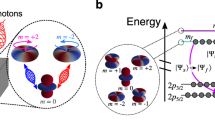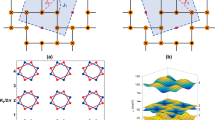Abstract
The Borrmann effect1,2—a dramatic increase in transparency to X-ray beams—is observed when X-rays satisfying Bragg’s law diffract through a perfect crystal. The minimization of absorption seen in the Borrmann effect has been explained by noting that the electric field of the X-ray beam approaches zero amplitude at the crystal planes, thus avoiding the atoms. Here we show experimentally that under conditions of absorption suppression, the weaker electric quadrupole absorption transitions are effectively enhanced to such a degree that they can dominate the absorption spectrum. This effect can be exploited as an atomic spectroscopy technique; we show that quadrupole transitions give rise to additional structure at the L1, L2 and L3 absorption edges of gadolinium in gadolinium gallium garnet, which mark the onset of excitations from 2s, 2p1/2 and 2p3/2 atomic core levels, respectively. Although the Borrmann effect served to underpin the development of the theory of X-ray diffraction3,4,5,6, this is potentially the most important experimental application of the phenomenon since its first observation seven decades ago. Identifying quadrupole features in X-ray absorption spectroscopy is central to the interpretation of ‘pre-edge’ spectra, which are often taken to be indicators of local symmetry, valence and atomic environment7. Quadrupolar absorption isolates states of different symmetries to that of the dominant dipole spectrum, and typically reveals orbitals that dominate the electronic ground-state properties of lanthanides and 3d transition metals, including magnetism. Results from our Borrmann spectroscopy technique feed into contemporary discussions regarding resonant X-ray diffraction8 and the nature of pre-edge lines identified by inelastic X-ray scattering7. Furthermore, because the Borrmann effect has been observed in photonic materials, it seems likely that the quadrupole enhancement reported here will play an important role in modern optics.
This is a preview of subscription content, access via your institution
Access options
Subscribe to this journal
Receive 51 print issues and online access
$199.00 per year
only $3.90 per issue
Buy this article
- Purchase on Springer Link
- Instant access to full article PDF
Prices may be subject to local taxes which are calculated during checkout


Similar content being viewed by others
References
Borrmann, G. The absorbance diagram of quartz. Phys. Z. 42, 157–162 (1941)
Borrmann, G. Der kleinste Absorptionskoeffizient interferierender Rontgenstrahlung. Z. Kristallogr. Kristallgeom. Kristallphys. Kristallchem. 106, 109–121 (1954)
Darwin, C. G. The theory of X-ray reflexion. Phil. Mag. 27, 315–333 (1914)
Darwin, C. G. The theory of X-ray reflexion. Part 2. Phil. Mag. 27, 675–690 (1914)
Ewald, P. P. Zur Begrundung der Kristalloptik. Teil II. Ann. Phys. 49, 117–143 (1916)
Ewald, P. P. Crystal optics for visible light and X rays. Rev. Mod. Phys. 37, 46–56 (1965)
De Groot, F. High-resolution X-ray emission and X-ray absorption spectroscopy. Chem. Rev. 101, 1779–1808 (2001)
Dmitrienko, V. E., Ishida, K., Kirfel, A. & Ovchinnikova, E. N. Polarization anisotropy of X-ray atomic factors and ‘forbidden’ resonant reflections. Acta Crystallogr. A61, 481–493 (2005)
Von Laue, M. Röntgenstrahl-Interferenzen (Academische, Frankfurt, 1960)
Batterman, B. W. & Cole, H. Dynamical diffraction of X-rays by perfect crystals. Rev. Mod. Phys. 36, 681–717 (1964)
Borie, B. The theory of the Borrmann effect in terms of difference equations. Acta Crystallogr. 12, 470–472 (1966)
Feynman, R. P., Leighton, R. B. & Sands, M. The Feynman Lectures on Physics Vol. 2., Ch. 24-10–12 (Addison-Wesley, Reading, Massachusetts, 1964)
Brouder, C. Angular dependence of X-ray absorption spectra. J. Phys. Condens. Matter 2, 701–738 (1990)
Lovesey, S. W. & Collins, S. P. X-ray Scattering and Absorption by Magnetic Materials (Clarendon, Oxford, UK, 1996)
Vatanyants, I. A. & Zegenhagen, J. Photoelectric scattering from an X-ray interference field. Solid State Commun. 113, 299–320 (2000)
Schülke, W. & Mourikis, S. Nondiagonal momentum density of Si by coherent inelastic X-ray scattering. Acta Crystallogr. A 42, 86–98 (1986)
Batson, P. E. Symmetry-selected electron-energy-loss scattering in diamond. Phys. Rev. Lett. 70, 1822–1825 (1993)
Gordon, R. A. et al. High multipole transitions in NIXS: Valence and hybridization in 4f systems. Europhys. Lett. 81, 26004 (2008)
Wagenfeld, H. Normal and anomolous photoelectric absorption of X rays in crystals. Phys. Rev. 144, 216–224 (1966)
Loeffen, P. W. et al. Deconvolution of lifetime broadening at rare-earth LIII edges compared to resonant inelastic X-ray scattering measurements. Phys. Rev. B 54, 14877–14880 (1996)
Sawada, H. Electron density study of garnets: Z3Ga5O12; Z = Nd, Sm, GD, Tb. J. Solid State Chem. 132, 300–307 (1997)
Collins, S. P. et al. Station 16.3: a high-resolution single-crystal diffraction facility at the SRS, Daresbury. J. Synchotron Rad. 5, 1263–1269 (1998)
Krisch, M. H. et al. Evidence for a quadrupolar excitation channel at the LIII edge of gadolinium by resonant inelastic X-ray scattering. Phys. Rev. Lett. 74, 4931–4934 (1995)
Materlik, G., Müller, J. E. & Wilkins, J. W. L-edge absorption spectra of the rare earths: assessment of the single particle picture. Phys. Rev. Lett. 50, 267–270 (1983)
Chen, M. H., Crasemann, B. & Kostroun, V. O. Theoretical L2- and L3-subshell fluorescence yields and L2-L3X Coster-Kronig transition probabilities. Phys. Rev. A 4, 1–7 (1971)
Thole, B. T. et al. 3d x-ray-absorption lines and the 3d94fn+1 multiplets of lanthanides. Phys. Rev. B 32, 5107–5118 (1985)
Fabrizio, M., Altarelli, M. & Benfatto, M. X-Ray resonant scattering as a direct probe of orbital ordering in transition-metal oxides. Phys. Rev. Lett. 80, 3400–3403 (1998)
Brown, S. D. et al. Dipolar excitations at the LIII X-ray absorption edges of the heavy rare-earth metals. Phys. Rev. Lett. 99, 247401 (2007)
Zhang, Z. & Satpathy, S. Electromagnetic wave propagation in periodic structures: Bloch wave solution of Maxwell’s equations. Phys. Rev. Lett. 65, 2650–2653 (1990)
Ward, A. J., Pendry, J. B. & Stewart, W. J. Photonic dispersion surfaces. J. Phys. Condens. Matter 7, 2217–2224 (1995)
Acknowledgements
This paper is dedicated to R. F. Pettifer, who died on 5 March 2008, and whose numerous contributions to the field of synchrotron radiation included the original proposal of Borrmann spectroscopy. The authors are grateful to C. Nave and V. E. Dmitrienko for their comments on the manuscript.
Author information
Authors and Affiliations
Corresponding author
Supplementary information
Supplementary information
This file contains supplementary text, Supplementary Figure S1 and Supplementary References. (PDF 333 kb)
PowerPoint slides
Rights and permissions
About this article
Cite this article
Pettifer, R., Collins, S. & Laundy, D. Quadrupole transitions revealed by Borrmann spectroscopy. Nature 454, 196–199 (2008). https://doi.org/10.1038/nature07099
Received:
Accepted:
Issue Date:
DOI: https://doi.org/10.1038/nature07099
This article is cited by
-
Bragg-Primakoff axion photoconversion in crystal detectors
Journal of High Energy Physics (2024)
-
A unified formulation of dichroic signals using the Borrmann effect and twisted photon beams
Scientific Reports (2018)
-
Fano resonances in photonics
Nature Photonics (2017)
-
Resonant X-ray emission with a standing wave excitation
Scientific Reports (2016)
Comments
By submitting a comment you agree to abide by our Terms and Community Guidelines. If you find something abusive or that does not comply with our terms or guidelines please flag it as inappropriate.



